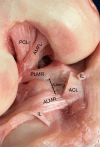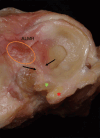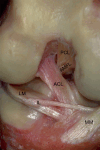Anatomy of lateral meniscus
- PMID: 38529162
- PMCID: PMC10929306
- DOI: 10.21037/aoj-20-118
Anatomy of lateral meniscus
Abstract
The anatomy of the lateral meniscus underlies the understanding of its unique biomechanics. Moreover, the knowledge of its microscopic structure, its vascularization and its ligament insertions can make us understand the rationale for its surgical treatment. It is well known as the respect of the anatomy leads to better results in reconstructive surgery. Knowing the differences in the shape and in the areas of insertion of the meniscal roots can be useful in case of reinserting a root or when performing a meniscal transplant. Learning about the capsular insertions, the anchoring ligaments and the areas of greatest mobility of the lateral meniscus is useful during meniscal repair and replacement surgery. This information can let us choose the most appropriate technique and the best device to face any kind of meniscal lesion. In this article, we will consider both the micro and the macro meniscal structure in order to be able to give a description as complete as possible of this fundamental structure. We will consider the interrelation of the meniscus with the neighboring anatomical structures with which it contributes to the biomechanical control of the joint. It is important to understand the interrelation with both anterior and posterior cruciate ligament (PCL) given that frequently a combined meniscal and ligamentous reconstruction is necessary.
Keywords: Lateral meniscus; anatomy; meniscal ligament; meniscal root.
2022 Annals of Joint. All rights reserved.
Conflict of interest statement
Conflicts of Interest: All authors have completed the ICMJE uniform disclosure form (available at https://aoj.amegroups.com/article/view/10.21037/aoj-20-118/coif). The series “The Lateral Meniscus” was commissioned by the editorial office without any funding or sponsorship. JCM received payment for lectures from Smith & Nephew. The authors have no other conflicts of interest to declare.
Figures











References
Publication types
LinkOut - more resources
Full Text Sources
